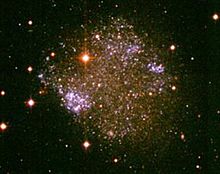Galactocentrism
In
Thomas Wright and Immanuel Kant first speculated that fuzzy patches of light called nebulae were actually distant "island universes" consisting of many stellar systems.[3] The shape of the solar system's own parent galaxy was expected to resemble such "islands universes," but "scientific arguments were marshalled against such a possibility," and this view was rejected by almost all scientists until Edwin Hubble's measurements in 1924.[4]
William Herschel's heliocentric model of the universe, which was regarded as the standard model of cosmology in the 19th century, was overthrown by astronomer Harlow Shapley's work on globular clusters in 1918. Shapley's research marked the transition from heliocentrism to galactocentrism,[5][6][7] placing the Galactic Center of the Milky Way Galaxy far away from the Sun, towards Sagittarius. Heber Doust Curtis and Edwin Hubble further refuted the heliocentric view of the universe by showing that spirals are themselves far-flung galactic systems. By 1925, the galactocentric model was established.[7]
The theory of galactocentrism was an important step in the development of
Harlow Shapley and galactocentrism
Shapley had been studying the

In 1920 Heber Doust Curtis and Harlow Shapley participated in the Great Debate on the nature of nebulae and galaxies, and the size of the universe. Shapley believed that distant nebulae were relatively small and lay within the Milky Way Galaxy. Curtis advocated the now-accepted view that nebulae were farther away, and that other galaxies apart from the Milky Way therefore existed.[7] By 1925,
"The realization, only a few decades ago, that our Galaxy is not unique and central in the universe ranks with the acceptance of the Copernican system as one of the great advances in cosmological thought." George O. Abell[7]
When astronomers realized that starlight can be absorbed by clouds of gas and dust, infrared radiation was used to penetrate the dust clouds.[12] Estimates dating after 2000 locate the Solar System within the range 24–28.4 kilolight-years (7.4–8.7 kiloparsecs) from the Galactic Center of the Milky Way galaxy.[13]
Shift from galactocentrism to acentrism
Hubble's observations of redshift in light from distant galaxies indicated that the universe was
References
- ^ "Definition of galactocentric". Merriam-Webster Dictionary. Retrieved 6 June 2018.
- ^ "Definition of galactocentric in English". English Oxford Living Dictionaries. Retrieved 6 June 2018.[dead link]
- ISBN 978-0-521-66148-5
- . Retrieved 26 August 2020.
- arXiv:1110.2445.
- ^ doi:10.1086/128228
- ^ .
- ^ doi:10.1038/240429a0
- ^ Roberts, Jacob (2017). "A Giant of Astronomy". Distillations. 3 (3): 6–11. Retrieved May 16, 2018.
- doi:10.1086/143018.
- ISBN 978-0313345364.
- ^ "Meet the Stargazers". WHYY. Retrieved 6 June 2018.
- S2CID 119235554.
